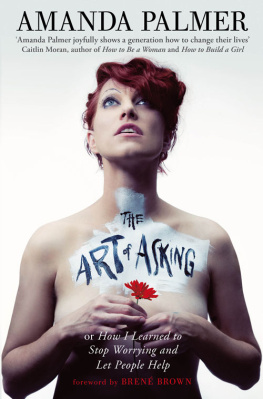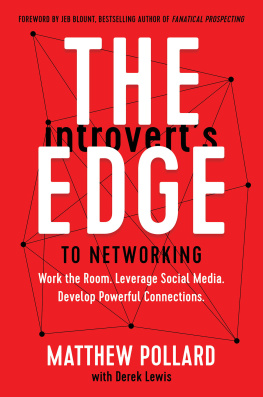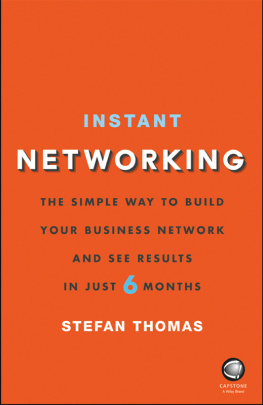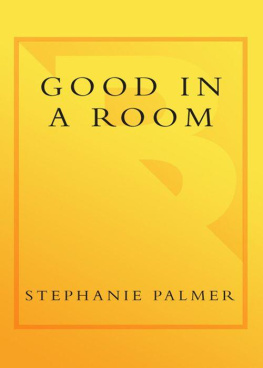
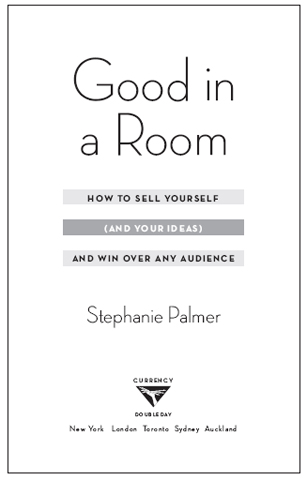
Contents
Part I
How to Swim with Sharks
Part II
Titles, Teasers, and Trailers
Part III
Getting in the Room
Part IV
Inside the Room
Part V
Mini-Meetings
Part VI
Troubleshooting
To Jean, George, and Tim
Good in a room adj. Hollywood: Term used by agents and managers to describe their clients who pitch well. Corporate: Capable of making compelling presentations in meetings and persuading colleagues, clients, and decision makers. Personal: Able to connect with people easily and make a favorable impression.
Introduction
Y ou walk through the revolving doors into a three-story lobby. The space is silent. The air is cool. It feels like a museum. You walk across the marble floor, each footstep producing an echo, until you reach the massive marble reception desk.
Behind the desk are four security guards in crisp navy suits. You tell one of the guards your name and whom you are going to see. The guard places a phone call and then gives you a security pass. Another security guard ushers you into a steel and mirror-paneled elevator. He presses the button for the top floor.
You exit the elevator into the luxurious reception area. In front of you is a mahogany reception desk staffed by a strikingly attractive assistant. She welcomes you by name and says, Please have a seat. Ill let them know youre here.
A slight chill runs up your spine. Them? You had expected to meet only with the chief operating officer (COO). But before you can sit down in one of the club chairs in the waiting area, another assistant emerges from the hallway and leads you into a private conference room with a rectangular marble table surrounded by twelve Aeron chairs. The assistant gestures toward rows of bottled water on a buffet table against the wall. Smartwater, Fiji, or Perrier? he asks.
Then you wait for thirty minutes. The calm faade you brought in with you starts to evaporate. You fantasize about what could happen if they say yes. You worry about what could happen if they say no. You might never get in this room again.
You start to sweat.
Then you remember what you learned from reading this book, Good in a Room. You have a comprehensive strategy for each of the five stages of the meeting. You know how to avoid the secret traps that take most people out of the running. And when the time comes to pitch your idea, you know exactly what to say and how to say it.
Suddenly the COO enters. Following the COO is the CEO, the vice chairman, and the president of the company. Everyone takes their seats and the meeting begins.
Twenty minutes later, the meeting ends smoothly. The room is warm with enthusiasm and the executives smile as they shake your hand. The COO sees you out the door. He says, Well talk it over and get back to you soon.
The next day, you get the call: Yes. A wave of relief washes over you and the muscles in your shoulders begin to relax. You did it. You got in the right room with the right people and delivered a winning pitch.
Best of all, your confidence has grown substantially. With this experience under your belt, youll be better positioned for the next high-stakes meeting and decision makers will be more inclined to say yes to your ideas.
Youve broken through to the next level in your professional life. Youre excited about your future. You know that youll be hearing the word yes a lot more often.
Thats what its like to be good in a room.
CHAPTER 1
Why You Should Read This Book
T he reason you should read this book is because the strategies and tactics that people use to sell ideas in Hollywood work in the rest of the business world. I have worked with entrepreneurs, executives, and professionals in industries such as real estate, financial services, retail sales, law, advertising, marketing, video games, and more. The techniques used to sell ideas in Hollywood not only work in other industries, they often work better.
As you already know, good in a room is a Hollywood term referring to creative people who excel at pitching in high-stakes meetings. Ive hadliterallythousands of these meetings. During my time as a studio executive at MGM, I had over three thousand pitch meetings where writers, directors, stars, and producers would try to persuade me to buy their ideas.
Most of the time, ideas are pitched poorly. However, there are some people who succeed all the time. Over a period of years, I paid attention to what worked and what didnt. I identified the techniques that were being used in all of the successful meetingsregardless of who was pitching. I also found a considerable number of ways that the person pitching could break the deal, often without knowing it.
Many studio executives, or suits, have backgrounds in sales, marketing, or finance. My degree is in theatrical directing from Carnegie Mellon. So when I started hearing pitches, I wasnt just thinking about whether to say yes or no. I was seeing the meeting as a theatrical performance.
Unfortunately, most writers, like most people, do not have a comprehensive strategy to deliver a great performance. When the time comes to pitch in a high-stakes situation, even someone experienced can stumble and ruin a golden opportunity without a solid meeting technique.
When someone with a great idea doesnt present it effectively, it not only hurts them, but all of us as well. Why? Because mediocre ideas will get purchased and produced if superior ideas arent pitched well enough.
The fact is that when it comes to making a buying decision, buyers can more easily evaluate the information on the surface, i.e., the pitch. Its harder to evaluate whats inside. As you know, this is true beyond Hollywood. In a grocery aisle, success is determined more by the design and copywriting on the packaging than by the quality of the product. In job interviews, hiring decisions tend to look past differences in work experience and focus on how the candidates perform in the room. My point is not that pitching is everything. Rather, its that good products deserve good packaging and great ideas deserve a great pitch.
Even shy, awkward, introverted people can learn to pitch well. One of my highlights from MGM was when I found a new writer named Mike who was pitching a high school comedy with a unique angle. His script was great, but his pitch was a disaster. He didnt know how to handle the small talk, he pitched too soon and with way too much detailhe broke the deal in a dozen different ways. Ordinarily I would just pass on his project, but I was frustrated with the quality of the movies we were making and I didnt want to send this great script back to the slush pile. So I coached Mike on how to perform in each stage of the meeting and told him exactly what to say when my boss asked, So, whats your project about?
The next day, Mike pitched his idea beautifully to my boss, and it sold right there in the meeting. Afterward, he told me that hed been staying on his brothers couch for the last three months and was preparing to move back in with his parents. With this one sale, his career was on an entirely new trajectory. And for me, in a job where so much of my time was spent surviving cutthroat politics and producing mediocre ideas, helping Mike succeed was really gratifying. I realized then that I wanted to focus on pitching, not production.
A year later, I left my executive job and started my own company, also called Good in a Room, to help writers and directors with quality ideas get the attention and financing they deserve. Then I did an interview with National Public Radio and I started getting some remarkable calls. A fashion designer wanted help bringing out his summer collection. A marketing exec wanted to get promoted to VP. A financial advisor wanted to find new clients and expand her business.
Next page



